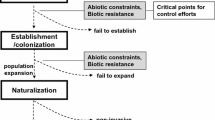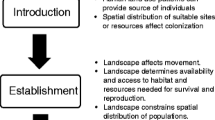Abstract
Attempts to classify certain habitats as vulnerable to invasion or plant traits as invasive have met with limited success and applicability. Clearly, not all plant invaders are able to exploit all habitats and not all habitats are equally susceptible to invasion. Here we argue that it is critical for a successful model for invasions to incorporate both environmental and species traits and present just such a framework. Although disturbance has been targeted as a crucial event which renders habitats vulnerable to invasion, disturbances are often integral parts of ecosystems (e.g. floods, tree-falls, fire, etc.) and are not always associated with invasion events. We argue that disturbances that are associated with invasions alter historical patterns of turnover, or flux, of resources in an ecosystem. Given this perspective on the relationship between invasions and disturbances, and the need to integrate species traits with those of invaded ecosystems, we have developed an approach to characterize plant invasion patterns that we call the ‘Disturbed Resource-Flux Invasion Matrix’ or DRIM. This is a 16-cell matrix that classifies habitats by the quality of changes in physical and chemical resource flux either increasing or decreasing flux relative to historical patterns. Within each matrix cell, it is then possible to apply basic ecological principles to target species traits that can facilitate successful invasion of habitats experiencing that particular kind of disturbance. We present examples from the literature of how habitats and species can be classified according to the DRIM, and demonstrate the application of this theoretical model.
Similar content being viewed by others
References
Baker HG (1964) Characteristics and modes of origin of weeds. In: Baker HG and Stebbins GL (eds) The Genetics of Colonizing Species, pp 147–168. Academic Press, New York
Barrett SCH and Richardson BJ (1986) Genetic attributes of invading species. In: Groves RH and Burdon JJ (eds) Ecology of Biological Invasions: An Australian Perspective, pp 21–33. Australian Academy of Science, Canberra
Busch DE and Smith SD (1993) Effects of fire on water and salinity relations of riparian woody taxa. Oecologia 94: 186–194
Busch DE and Smith SD (1995) Mechanisms associated with the decline of woody species in riparian ecosystems of the southwestern US. Ecological Monographs 65: 347–370
Burke MJ and Grime JP (1996) An experimental study of plant community invasibility. Ecology 77: 776–790
Crawford CS, Cully AC, Leutheuser R, Sifuentes MS, White LH and Wilber JP (1993) Middle Rio Grande ecosystem: Bosque biological management plan. Report submitted to US Fish and Wildlife Service, Albuquerque, New Mexico
Crawley MJ (1986) The population biology of invaders. Philosophical Transactions of the Royal Society of London B 314: 711–731
Crawley MJ (1987) What makes a community invasible? In: Cray AJ, Crawley MJ and Edwards PJ (eds) Colonization, Succession and Stability, pp 424–453. Blackwell Scientific Publications, Oxford
Cronk QCB and Fuller JL (1995) Plant Invaders: The Threat to Natural Ecosystems. London, Chapman & Hall
Cross JR (1981) The establishment of Rhododendron ponticum in the Killarny oakwoods, SW Ireland. Journal of Ecology 69: 807–824
D'Antonio CM (1993) Mechanisms controlling invasion of coastal plant communities by the alien succulent Carpobrotus edulis. Ecology 74: 83–95
D'Antonio CM and Mahall BE (1991) Root profiles and competition between the invasive exotic perennial, Carpobrotus edulis, and two native shrub species in California coastal scrub. American Journal of Botany 78: 885–894
Drake JA (1983) Invasibility in Lotka-Volterra interaction webs. In: De Angelis D, Post WM and Sugihara G (eds) Current Trends in Food Web Theory. Oak Ridge National Lab, California, USA
Elton CS (1958) The Ecology of Invasions by Animal and Plants. Methuen, London
Forcella F and Harvey SJ (1983) Relative abundance in an alien weed flora. Oecologia 59: 292–295
Goldberg DE (1990) Components of resource competition in plant communities. In: Grace JB and Tilman D (eds) Perspectives on Plant Competition, pp 27–49. Academic Press, San Diego, California
Green RE (1997) The influence of numbers released on the outcome of attempts to introduce exotic bird species to New Zealand. Journal of Animal Ecology 66: 25–35
Griffin GF, Stafford-Smith DM, Morton SR, Allan GE, Masters KA and Preece N (1989) Status and implications of the invasion of tamarisk (Tamarix aphylla) on the Finke River, Northern Territory, Australia. Journal of Environmental Management 29: 297–316
Harper JL (1965) Establishment, aggression, and cohabitation in weedy species. In: Baher HG and Stebbins GL (eds) The Genetics of Colonizing Species, pp 245–265. Academic Press, New York
Hink VC and Ohmart RD (1984) Middle Rio Grande biological survey. Report submitted to US Army Corps of Engineers, Albuquerque, New Mexico
Hobbs RJ (1989) The nature and effects of disturbance relative to invasions. In: Drake JA Mooney HA, di Castri F, Groves RH, Kruger FJ, Remánek M and Williamson M (eds) Biological Invasions: A Global Perspective, pp 389–406. John Wiley & Sons, Chichester
Hobbs RJ and Huenneke LF (1992) Disturbance, diversity, and invasion: implications for conservation. Conservation Biology 6: 324–337
Horton JS (1977) The development and perpetuation of the permanent tamarisk type in the phreatophyte zone of the Southwest. Contributed paper, Symposium on the Importance, Preservation, and Management of the Riparian Habitat, July 9, 1977, Tucson, Arizona, pp 125–127
Horvitz CC, Pascarella JB and Hofstetter RH (1998) Functional roles of invasive non-indigenous plants in hurricane-affected subtropical hardwood forests. Ecological Applications 8: 947
Huenneke LF and Thomson JK (1995) Potential interference between a threatened endemic thistle and an invasive, nonnative plant. Conservation Biology 9: 416–425
MacArthur HR and Wilson EO (1967) The Theory of Island Biogeography. Princeton University Press, Princeton, New Jersey, USA
Mack RN (1985) Invading plants: their potential contribution to population biology. In: White J and Harper JL (eds) Studies on Plant Demography: A Festschrift for John L. Harper, pp 217–253. Academic Press, London
Mack RN (1989) Temperate grasslands vulnerable to plant invasions: Characteristics and consequences. In: Drake JA, Mooney HA, di Castri F, Groves RH, Kruger FJ, Rejmánek M and Williamson M (eds) Biological Invasions: A Global Perspective, pp 491–507. John Wiley & Sons, New York
Mack RN (1996) Predicting the identity and fate of plant invaders: emergent and emerging approaches. Biological Conservation 78: 107–121
Melgoza G, Nowak RS and Tausch RJ (1990) Soil-water exploitation after fire — competition between Bromus-tectorum (cheat-grass) and 2 native species. Oecologia 83: 7–13
Mooney HA and Drake JA (1989) Biological invasions: a SCOPE program overview. In: Drake JA, Mooney HA, di Castri F, Groves RH, Kruger FJ, Rejmánek M and Williamson M (eds) Biological Invasions: A Global Perspective, pp 491–507. John Wiley & Sons, New York
Parker IM, Mertens SK and Schemske DW (1993) Distribution of seven native and two exotic plants in a tallgrass prairie in southeastern Wisconsin: the importance of human disturbance. American Midland Naturalist 130: 43–55
Pickard J (1984) Exotic plants on Lord-Howe island — distribution in space and time, 1853–1981. Journal of Biogeography 11: 181–208
Pysek P, Prach K, Wade M and Rejmánek M (1995) Plant Invasions: General Aspects and Special Problems. SPB Academic Publishers, Amsterdam
Rejmánek M (1996) A theory of seed plant invasiveness: the first sketch. Biological Conservation 78: 171–181
Robinson TW (1965) Introduction, spread, and areal extent of saltcedar (Tamarix) in the western states. Geological survey professional paper 491-A. United States Government Printing Office, Washington, DC
Simberloff D (1981) Community effects of introduced species. In: Nitecki MH (ed) Biotic Crises in Ecological and Evolutionary Time. Academic Press, New York
Stromberg J (1998) Dynamics of Fremont cottonwood (Populus fremontii) and saltcedar (Tamarix chinensis) populations along the San Pedro River, Arizona. Journal of Arid Environments 40: 133–155
Stohlgren TJ, Binkley D, Chong GW, Kalkhan MA, Schell LD, Bull KA, Otsuki Y, Newman G, Bashkin M and Son Y (1999) Exotic plant species invade hot spots of native plant diversity. Ecological Monographs 69: 25–46.
Sugihara G (1983) Holes in niche space: a derived assembly rule and its relation to intervality. In: DeAngelis D, Post WM and Sugihara G (eds) Current Trends in Food Web Theory. Oak Ridge National Lab, California
Thomson AG, Radford GL, Norris DA and Good JEG (1993) Factors affecting the distribution and spread of Rhododendron in North Wales. Journal of Environmental Management 39(3): 199–212
Tilman D (1997) Community invasibility, recruitment limitation, and grassland biodiversity. Ecology 78: 81–92
Vitousek PM, Loope LL and Stone CP (1987) Introduced species in Hawaii: biological effects and opportunities for ecological research. Trends in Ecology and Evolution 2: 224–227
White PS and Pickett STA (1989) Natural disturbance and patch dynamics: an introduction. In: Pickett STA and White PS (eds) The Ecology of Natural Disturbance and Patch Dynamics, pp 3–16. Academic Press, Orlando, Florida
Williamson M (1996) Biological Invasions. Chapman & Hall, New York
Zink TA, Allen MF and Heindl-Tenhunen B (1995) The effect of a disturbance corridor on an ecological reserve. Restoration Ecology 3: 304–310
Author information
Authors and Affiliations
Rights and permissions
About this article
Cite this article
Sher, A.A., Hyatt, L.A. The Disturbed Resource-Flux Invasion Matrix: A New Framework for Patterns of Plant Invasion. Biological Invasions 1, 107–114 (1999). https://doi.org/10.1023/A:1010050420466
Issue Date:
DOI: https://doi.org/10.1023/A:1010050420466




